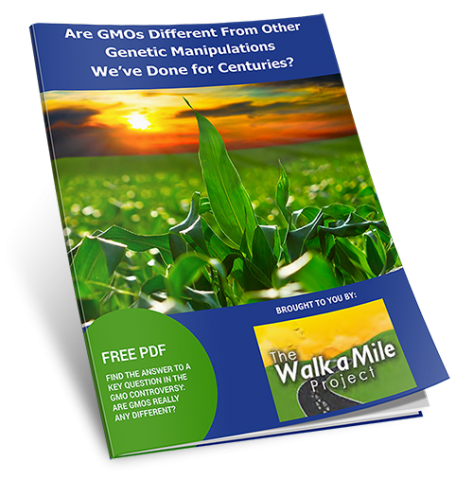On the Same Day They Approved GMO Salmon, The FDA Also Did This to GMO Labeling
Less than two weeks ago, the FDA announced their approval of GMO salmon, but that wasn’t the only big announcement they made that day. As reported by Nutritional Outlook —
“
The agency released final guidance on voluntary GMO labeling for foods derived from genetically modified (GM) plants.”
With HR 1599 recently passed by the house, and a labeling initiative underway in the Senate as well, this was not a surprise, and don’t get the wrong idea, as it’s really just tightening up its rules for voluntary labeling.

The FDA set new GMO labeling guidelines. Original Photo: https://lintvwwlp.files.wordpress.com/2014/03/gmo.jpg?w=650
Let’s take a look at the main components of the new FDA guidelines…
GMO Labeling From Plants
On a voluntary basis, food manufacturers may label their foods with information about whether the foods were not produced using bioengineering.
Don’t Say “Not Genetically Modified”
Not surprisingly, many consumers confuse hybridization and cross-breeding with genetic modification. Because of this, the FDA recommends stating the ingredient was genetically engineered rather than modified.
“As such, the agency says that instead of stating that an ingredient is “not genetically modified,” companies should instead use wording such as “not genetically engineered” or “not genetically modified through the use of modern biotechnology [emphasis added].”
Eric will likely be touching on this in more detail soon over at The Walk a Mile Project, as the term “modern biotechnology” comes off a bit biased from the FDAs standpoint. First off, hybridization and cross-breeding aren’t even biotechnology, and second, is there any antiquated biotechnology? It’s all new within the last handful of decades, and this deliberate word choice smacks of favoritism by the FDA.
Also, they are looking to move everyone away from the term GMO, because —
The “O” in the acronym “GMO” refers to the word “organism.” Most foods do not contain entire organisms (foods such as yogurt that contain microorganisms are exceptions); however, in some formulations this acronym may be read as meaning that the food was not derived from a genetically engineered organism, such as a plant that has been genetically engineered. In light of potential confusion regarding the meaning of the acronym “GMO,” FDA encourages manufacturers to consider the use of other types of statements to indicate that a plant-derived food has not been produced using bioengineering, as described above. For example, a statement that “our tomato growers do not plant bioengineered seeds” or “this oil is made from soybeans that were not genetically engineered” could be used.
Sounds like they’re trying to move away from a term that has gradually developed some negative connotations over the past 20 years. Interesting…
Don’t Say “GMO Free”
This surely won’t make anyone in the anti-GMO camp very happy, but —
“FDA also discourages wording affirming a complete absence of GMOs, including “GMO free,” “non-GMO,” or “does not contain GMOs.” The agency reasons that it is difficult to substantiate a complete “free from” claim guaranteeing total absence.”
If you’re feeling that this may go hand-in-hand with the whole “throwing in the towel” vibe that came out of the House of Representatives hearings earlier in 2015 (see GMO TRUTH Podcast #8), then you’re not alone.
Also, manufacturers are encouraged to be more specific, such as “our tomato growers do not plant bioengineered seeds” or “this oil is made from soybeans that were not genetically engineered.”
Context
Companies can’t tout what is not genetically engineered then stay silent on GMO ingredients. Alternatively, if non-GM ingredients are called out as an alternative to a GM ingredient, there should be a sufficient amount of the non-GM ingredient present in the product to make a difference…but this begs the question what is a sufficient amount? The FDA provided no further information on this in the guidelines.
Also, manufacturers should ensure their labels—both graphics and wording—do not imply a product is inherently safer than genetically engineered counterparts.
Differences in Nutritional Content
Last of all, the site reports that —
Labels should disclose the fact that a food is produced from genetically engineered plants to create significantly different nutritional properties, such as boosting the amount of a specific vitamin or mineral in an ingredient.
Honestly, were it not for the GMO salmon news bomb that the FDA dropped at the exact same time, I have a feeling that people would be having a field day with these new labeling guidelines, but instead they seem to have crept under the radar a bit. We’ll see how this progresses.
Claims Substantiation
As for putting all this into practice, companies need to prove their GMO or non-GMO claims through the channels in place and must use validated analytical methods to confirm the absence or presence of GM material.
Nutritional Outlook pledges that they “will continue reporting on this story, including implications for the voluntary GMO-labeling bill, the Safe and Accurate Food Labeling Act, which is currently awaiting a Senate vote.” And we’ll be right there with them.
Read the full article at http://www.nutritionaloutlook.com/regulatory/fda-issues-gmo-labeling-final-guidance-foods-derived-plants
And view the entire FDA Guidance here:
http://www.fda.gov/Food/GuidanceRegulation/GuidanceDocumentsRegulatoryInformation/ucm059098.htm



